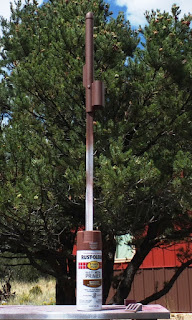(BAR-35) Ovaltine
A rocket with no flat fins... and only one tube fin... in the shape of an oval.
BT/C-50H and a BT/C-60 oval tube.
2024-08-07 Tubing or not Tubing
BT-50H, C-50 and the tube fin. I turned the nose cone from some 1" diameter pine dowel stock.
2024-08-10 Launch Lug
A BT-3 tube is used as the Launch Lug. I also used a piece of 1/4" dia. pine dowel x 1-1/8" long as the anchor for the Kevlar shock chord. You can see it poking out of the BT-50H.
2024-08-11 New Nose Cone
I didn't like the "Flat" Nose Cone so a I made new "Ram Jet" style nose cone from a piece of 1" diameter pine dowel. I also made some ballast from a 3/8"-16 threaded stud.
First coat of primer was Rustoleum 2 in 1 Filler Sandable. After that dried I applied CWF to the glue fillets. Also applied Spar Urethane to the nose cone to fill the wood grain.
2024-09-14 Painted Bore of Oval Fin Yellow
Launch Report: Ovaltine
Date: 2025-05-12
Background
This is a single stage scratch design / built rocket.
This rocket has no conventional flat fins, instead it has one oval tube fin.
The tube fin started out as a BT/C-60 that was formed into an oval.
It's a 24mm min diameter rocket with standard deployment of the chutes.
This rocket has no conventional flat fins, instead it has one oval tube fin.
The tube fin started out as a BT/C-60 that was formed into an oval.
It's a 24mm min diameter rocket with standard deployment of the chutes.
On Site Preparations
For a parachute I used a 12” Nylon chute.
An igniter was installed in the motor and secured via a rubber band.
The rocket was slid onto the 5/16" launch rod and the controller wires were attached to the igniter leads.
The site was clear and no outside observers were present.
An igniter was installed in the motor and secured via a rubber band.
The rocket was slid onto the 5/16" launch rod and the controller wires were attached to the igniter leads.
The site was clear and no outside observers were present.
Launch
Wind was out of the Southwest and was about 4 mph.
The Estes C6-5 motor ignited and the rocket leaped off the pad.
It flew stable upward to apogee (150 ft) where it tumbled and came back to Earth.
The rocket landed 92 feet from the launch pad, to the West.
The Estes C6-5 motor ignited and the rocket leaped off the pad.
It flew stable upward to apogee (150 ft) where it tumbled and came back to Earth.
The rocket landed 92 feet from the launch pad, to the West.
Flight Profile
The rocket nosed over into a zig-zag flight profile.
It ground hit and then the parachute ejected while on the ground.
It ground hit and then the parachute ejected while on the ground.
Condition of rocket after the flight
The rocket was surprisingly undamaged.
Conclusions
The rocket was stable during thrust, but unstable during coast.
What I learned
This was a spectacular flight.
The photos and launch video reflected this flight accurately. However no photos were obtained of the rocket during the unstable flight.
The photos and launch video reflected this flight accurately. However no photos were obtained of the rocket during the unstable flight.





































No comments:
Post a Comment